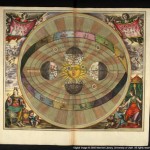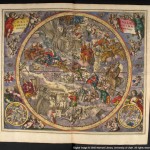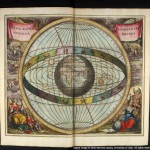Tags
Andreas Cellarius, astronomers, astronomy, atlas, burins, cartography, cherubs, compasses, Copernicus, Dutch, engraving, Europe, Galileo, Gerald Valk, gravers, illustrations, Jan Jansson, Pieter Schenck, Pope Paul V, printing press, Ptolemy, transits, Tycho Brahe
- Cellarius, Harmonia Macrocosmica, 1661
- Cellarius, Harmonia Macrocosmica, 1661
- Cellarius, Harmonia Macrocosmica, 1661
Harmonia Macrocosmica
Andreas Cellarius
Amsterdam: Jansson, 1661
Second edition
QB41 C39
The Celestial Atlas of Harmony was published in varying formats in 1660, 1661, 1666, and 1708. Very few copies of the first edition of 1660 survive. (One known copy is held by the British Museum). The Harmonia Macrocosmica, a summary of pre-Newtonian astronomy, compares the various cosmological theories up to and of that time, including those of Ptolemy, Tycho Brahe, and Copernicus.
The geocentric theories of Ptolemy, suggesting that the earth is the center of the universe, are contrasted with those of Copernicus, who put the sun at the center of our solar system. Tycho Brahe’s theory attempted to unify the two. Brahe’s version shows the sun revolving around the earth and the rest of the planets revolving around the sun.
The book also has sections on the Earth’s climate zones, the sizes of the sun, moon, and planets, and the constellations of the zodiac. It is this broad overview of astronomical thought that kept the book from being banned under strictures put in place by Pope Paul V in 1616. These same strictures put Galileo under house arrest for the rest of his life after the printing of his Dialogo (1632), which was based on Copernican theory.
Andreas Cellarius was the rector of a college in the northern Netherlands. The printer, Jan Jansson, was one of the preeminent publishers of his time. Both art and science were applied to this production, with discoveries heralded by imaginative images as well as observed fact. Cheerful cherubs, floating over head earnest astronomers hold transits and compasses. The first edition was extremely popular, prompting the second edition.
The second edition of the atlas contains twenty-nine lavishly designed and hand-colored engraved plates, some of the finest examples of seventeenth-century Dutch cartography in existence. The technique of engraving began in ancient times as a way to decorate objects, particularly of metal. After the development of the printing press in Europe in 1450, engraving became a way to create high quality illustrations which retained precise detail, even after multiple impressions. Specialized tools, known as “burins” and “gravers” of various sizes and shapes were used to cut away the surface of a metal plate. The 1708 reissue bears the engraved names of Gerald Valk and Pieter Schenck on each plate, although not one line had been changed.
View more images at the J. Willard Marriott Library Digital Library





You must be logged in to post a comment.